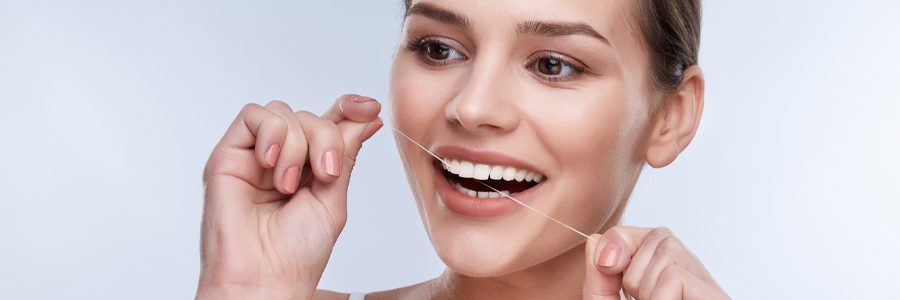Oral Hygiene Aids Rifkin Raanan Beverly Hills Cosmetic Dentistry

Regular dental check-ups are an essential component of excellent oral hygiene. They are also crucial in recognizing / diagnosing potential problems—but they are not a “fix-all” solution. If you want to avoid future dental problems, the most important of all dental practices is the conscientious use of thorough oral homecare routines, practiced on a daily basis.

Periodontal disease (also referred to as “gum disease” and “periodontitis”) is the leading cause of tooth loss in the developed world. This seems unnecessary, as periodontal disease is completely preventable in most cases. With a combination of daily self-cleaning and twice per year professional cleanings, most of disease-causing bacteria and plaque can be removed. As an extra benefit, when teeth are well cared for, you’ll have a sparkling, white smile.
Many types of oral hygiene aids are available on drug-store and supermarket shelves. It may be difficult to determine which of them offers the best benefit for your teeth.
The following list includes some of the common oral hygiene aids available for homecare:
The most common interdental and sub-gingival (beneath the gum) cleaner is dental floss. It is marketed in a variety of types and even in several flavors. The floss itself is made either from polyethylene ribbon or thin nylon filaments. It is useful for the removal of food particles and plaque from between the teeth and beneath the gum-line. Be careful, though! Excessively vigorous flossing can cause damage and bleeding of soft tissues. It’s important that you take great care when flossing. Flossing should normally be done twice daily, after brushing.
Many hygienists and periodontists recommend the use of interdental brushes in addition to dental floss. Interdental brushes are tiny brushes that are gentle on the gums. They are very effective in cleaning the contours of teeth between the gums. Interdental brushes are available in a variety of sizes and shapes.
Two basic types of mouth rinse are readily available: Cosmetic rinses, sold over the counter, are commonly used to temporarily suppress halitosis (bad breath). Therapeutic rinses may or may not require a prescription. In general, dentists tend to be skeptical of the purported benefits of cosmetic rinses. Several scientific studies have found that their effectiveness against plaque is, at best, minimal. Therapeutic rinses are regulated by the FDA, and contain active ingredients that are effective in reducing bad breath, plaque, and cavities. In general, oral rinses should be used after brushing.
Oral irrigators, such as “Water Jets” and “Waterpiks” are marketed as a way to clean debris from below the gum line. These devices use a continuously sprayed jet of water which is directed into the gum pockets (sulcus), and which can help remove harmful bacteria and food particles. Oral irrigators have been shown to be effective in lowering the risk of gum disease, but they should not be seen as a replacement for regular brushing and flossing. Regardless of which dental hygiene regimens you use at home, you should still schedule professional cleanings at least twice annually to remove deeper debris, and to inspect for any hidden problems.
Rubber tip stimulators are excellent tools for removing plaque from near the gum line, and they are useful in stimulating blood flow to the gums. In use, a rubber tip stimulator should be gently traced gently along the base of the teeth along the outer and inner gum line. It is recommended that this be done at least once per day. Any plaque that may adhere to the tip should be rinsed off with tap water. It’s important that you replace the tip whenever it begins to appear worn, and it should be stored in a cool, dry place.
Tongue cleaners (sometimes called “tongue scrapers”) are special devices designed to safely remove the buildup of food debris, fungi and bacteria from the tongue surface. When fungi and bacteria colonize on the tongue, they are likely to contribute to halitosis (bad breath), and have also been shown to contribute to a variety of systemic diseases such as heart disease, respiratory disease, stroke, and diabetes. Tongue cleaners may be made of wood, plastic or metal, and are shaped to be compatible with the natural contours of the tongue. To prevent the ingestion of fungi and bacteria, it is recommended that tongue cleaning be done prior to brushing.
There is a broad range of available toothbrush sizes and types. Dentists often recommend electric toothbrushes, because they have been shown to be much more effective than traditional manual brushes. The electric brush’s rotary or vibrating motion aids in removing food particles and dislodging plaque that may have lodged around the gums and teeth. Good cleaning is possible when using a manual tooth-brush, but the process requires considerably more effort.
Manual toothbrushes or electric toothbrush tips should be replaced at least every three months, because as bristles wear, they become ineffective. To avoid damage to gum tissue, soft bristle toothbrushes are preferred, rather than medium and hard bristle brushes. It’s also important to select an ADA approved toothbrush of a proper size to allow proper cleaning of all areas, of all teeth. Ideally, teeth should be brushed after each meal—as a minimum, brush twice each day.
If you have any questions about personal dental care devices, or to schedule an appointment with one of the best Beverly Hills cosmetic dentists, contact us today!

Come in for a consultation and find out all about the best cosmetic dentistry in Beverly Hills. Let Rifkin Raanan help you Own Your Smile™.
Call Now (310) 205-5300 / Book an Appointment